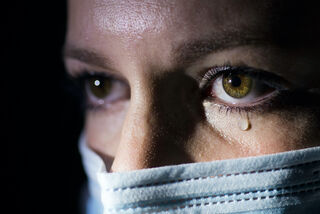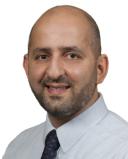Health
Invisible Wounds of the Frontline Heroes
Stress and trauma among health care workers caring for COVID patients.
Posted June 17, 2020 Reviewed by Lybi Ma

This post was written by Megan MacKenzie and Sydney Daviskiba, Wayne State University School of Medicine M.D. Candidates 2022
The coronavirus disease 2019 (COVID-19) has impacted our lives in more ways than meets the eye. Most of the United States population is ordered to stay at home to slow the spread of the disease, and lives have been completely upended. As of this writing, the U.S. leads the world with more than 2 million confirmed cases and more than 100,000 deaths caused by COVID-19.
At the frontline of this battle are health care workers and first responders, dealing with not only the stressors of daily life during a pandemic, but also an unprecedented flux of dying patients, lack of resources, ever-changing guidelines, and uncertainty surrounding COVID-19 treatments.
We are a psychiatrist specialized in trauma and stress and two third-year medical students passionate about advocating for health care workers' well-being, who decided to share our understanding of stress and trauma in this population with the readers.
Why are they stressed?
Health care workers worldwide are trained to manage the intense stressors of everyday medical work; however, this pandemic is uniquely stressful, even to highly trained professionals. The high mortality and contagiousness, abundant unknowns, and limited treatment options leave health care workers frustrated, overwhelmed, and scared. Many attempt to separate their at-home lives from their work lives—but what happens when the fear of contracting and transmitting COVID-19 transcends these fine lines?
Numerous global studies have revealed universal feelings of stress among health care workers. One study in China found that half of the healthcare workers had symptoms of depression, 44 percent had anxiety, and 71 percent distress. Another review revealed anxiety and depression between 16-28 percent in health care workers. Similar levels of stress, trauma, and depression are reported from European countries hit hardest by the pandemic, such as Italy.
Frontline health care workers in America
With the current U.S. administration’s mishandling of the coronavirus threat, America is now one of the most contaminated countries in the world. Understandably, our health care system is severely stressed. As the public gets restless with restrictions and numb to the numbers, health care workers get no relief from the onslaught of carnage from COVID-19. The irony of being called a “health care hero” by the same people who protest carelessly sans masks is not lost on any of us. The betrayal hurts.
Frontline workers describe their daily work as entering a battlefield, where death is imminent, and fear extends beyond the fates of their patients: “I feel like I’m going to die every day… I don’t want to die, but I think that it will happen”.
This story is not unique.
We know from previous natural and manmade disasters in the U.S. that the impact is high on frontline workers here also. For instance, the rate of post-traumatic stress disorder and depression among different groups of 9/11 first responders and health care workers were up to 20 percent, with the continuation of a variety of symptoms of anxiety, depression, and PTSD even 15 years later. Similarly, 20 percent of emergency nurses working with victims of hurricane Katrina showed symptoms of PTSD. In the current pandemic, these outcomes can be impacted by concerns about PPE shortage, the politicization of the pandemic and health care, fear of contracting or transmitting the illness, or financial constraints. This is specifically important in light of the immense financial stress on the health care system and an abundance of furloughs and layoffs.
What can we do to help?
There is no doubt this pandemic will leave many Americans and health care workers with psychological wounds. How we address them now can determine years of mental and physical health issues in their future.
An important principle of medical practice can be applied by responsible citizens who want to help: “First, do no harm!” As difficult as it may feel to stay locked down, continuing to follow necessary safety measures can make a huge impact. “Flattening the curve” and “raising the line” are more than just catchy phrases. The precarious scale that balances our health care system can easily topple if people leave their homes and spread the virus. If the measures taken to keep people safe appear to be an overreaction, that means they worked.
As states begin to loosen restrictions, it is crucial to remember that the threat of the virus has not disappeared. You might not be on the frontline, but you can help those who are. Continue to practice physical distancing, wear a face cover in public, and listen to qualified scientists regarding proper safety precautions. Despite what you might see on social media, these measures work. The best way to show respect and gratitude to the health care workers risking their lives to fight COVID-19 is to practice guidelines that keep others safe and reduce the burden that they will ultimately carry.
Importantly, providing mental health services to frontline workers must be part of our recovery plan. The earlier the negative impact of stress and trauma is mitigated, the less the long-term impact on mental and physical health. There are now a number of services nationwide that offer telepsychiatry and online support groups. Given the extremely busy work schedule of health care workers, flexibility must be an integral part of such plans. Our and other academic departments of psychiatry are providing free mental health services via phone and video in the form of telemedicine for our frontline workers. We have to take care of the people who take care of us.
It is important to remember that this pandemic will eventually pass, but our acts of kindness, unity, and support will have long-lasting, positive effects on our communities at large.




